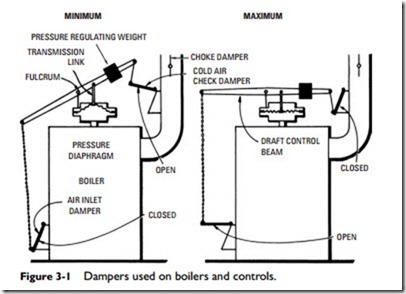Firing Anthracite Coal
Anthracite coal is preferred over other coal for domestic heating purposes because it produces a steadier and cleaner flame. Further- more, it burns longer and with greater heat than the others. The principal objections to using anthracite coal are that it requires more heat than other coals to start combustion and is slightly more expensive.
Anthracite coal is available in a number of different standardized sizes, each suited to a different size of grate and firepot. The fol- lowing are some of these coal sizes and their descriptive names:
• Buckwheat
• Egg
• Stove
• Chestnut
• Pea
• Broken
Buckwheat-size coal is available in five grades or sizes: Buckwheat No. 1; Buckwheat No. 2, or Rice size; Buckwheat No. 3, or Barley size; Buckwheat No. 4; and Buckwheat No. 5. Buckwheat Anthracite No. 2 (or Rice size) finds the widest use in automatic coal-firing equipment and is used in domestic, commercial, and industrial stokers.
There are certain recommended practices to be followed when firing buckwheat coal. For best results, the following techniques should be employed:
1. Always maintain a uniform low fire. This reduces clinker formation to a minimum and enables those clinkers that do form to be broken up more easily.
2. Use a smaller mesh grate when possible or a domestic stoker.
Because of its relatively small size, buckwheat anthracite coal often falls through the openings on ordinary grates when they are shaken.
3. Immediately after coaling, push a poker down through the fresh bed of buckwheat anthracite coal and expose a portion of the hot fire. This tends to prevent delayed ignition and such undesirable accompanying side effects as furnace or boiler doors being blown open.
4. Keep the heating system warm at all times. Allowing it to cool down and then having to warm it up results in burning fuel at a higher rate.
Egg-size coal should be used in large firepots (24-inch grates or larger). This is a deep-firing coal, and the most suitable results are obtained with fuel beds that are at least 16 inches deep.
Stove-size coal was extensively used in heating buildings, although today it has been largely replaced by gas or oil. It is used on grates that are 16 inches or larger. The fuel bed should be at least 12 inches deep.
Chestnut-size coal is used for firepots as large as 20 inches in diameter. Fuel beds for this anthracite coal range in depth from 10 to 15 inches.
With careful firing, pea-size coal can be burned on standard grates. Care should be taken not to overshake the grates (shake only until the first bright coals begin to fall through the grates). After a pea-coal fire has been built, the thickness of the fuel bed should be increased by the addition of small charges until it is at least level with the sill of the fire door. A common method of firing pea coal consists of drawing the red coals toward the front of the firebox and piling fresh fuel toward the back of the firebox.
A strong draft is required when burning pea coal. Figure 3-1 illustrates a satisfactory method of burning this coal size in a boiler. The choke damper is kept open and regulated by means of the cold air check and air inlet dampers. In stoker firing, the air setting is generally kept lower for pea coal because an excess of air under this kind of coal will burn up the retort. Forced draft and small mesh grates are frequently used for burning buckwheat anthracite coal.
